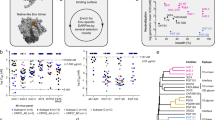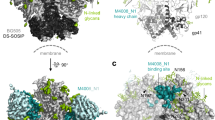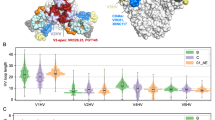Abstract
Binding of the third variable region (V3) of the HIV-1 envelope glycoprotein gp120 to the cell-surface coreceptors CCR5 or CXCR4 during viral entry suggests that there are conserved structural elements in this sequence-variable region. These conserved elements could serve as epitopes to be targeted by a vaccine against HIV-1. Here we perform a systematic structural analysis of representative human anti-V3 monoclonal antibodies in complex with V3 peptides, revealing that the crown of V3 has four conserved structural elements: an arch, a band, a hydrophobic core and the peptide backbone. These are either unaffected by or are subject to minimal sequence variation. As these regions are targeted by cross-clade neutralizing human antibodies, they provide a blueprint for the design of vaccine immunogens that could elicit broadly cross-reactive protective antibodies.
This is a preview of subscription content, access via your institution
Access options
Subscribe to this journal
Receive 12 print issues and online access
209,00 € per year
only 17,42 € per issue
Buy this article
- Purchase on SpringerLink
- Instant access to full article PDF
Prices may be subject to local taxes which are calculated during checkout





Similar content being viewed by others
Change history
21 July 2010
In the version of this article initially published online, ∼4 residues should have read ∼13. In addition in figure 1a, circulet should have read circlet. These errors have been corrected for the print, PDF and HTML versions of this article.
References
Douek, D.C., Kwong, P.D. & Nabel, G.J. The rational design of an AIDS vaccine. Cell 124, 677–681 (2006).
Zolla-Pazner, S. Identifying epitopes of HIV-1 that induce protective antibodies. Nat. Rev. Immunol. 4, 199–210 (2004).
Montefiori, D., Sattentau, Q., Flores, J., Esparza, J. & Mascola, J. Antibody-based HIV-1 vaccines: recent developments and future directions. PLoS Med. 4, e348 (2007).
Feng, Y., Broder, C.C., Kennedy, P.E. & Berger, E.A. HIV-1 entry cofactor: functional cDNA cloning of a seven-transmembrane, G protein-coupled receptor. Science 272, 872–877 (1996).
Dragic, T. et al. HIV-1 entry into CD4+ cells is mediated by the chemokine receptor CC–CKR-5. Nature 381, 667–673 (1996).
Deng, H. et al. Identification of a major co-receptor for primary isolates of HIV-1. Nature 381, 661–666 (1996).
Huang, C.C. et al. Structures of the CCR5 N terminus and of a tyrosine-sulfated antibody with HIV-1 gp120 and CD4. Science 317, 1930–1934 (2007).
Kwong, P.D. et al. Structure of an HIV gp120 envelope glycoprotein in complex with the CD4 receptor and a neutralizing human antibody. Nature 393, 648–659 (1998).
Huang, C.C. et al. Structure of a V3-containing HIV-1 gp120 core. Science 310, 1025–1028 (2005).
Zhou, T. et al. Structural definition of a conserved neutralization epitope on HIV-1 gp120. Nature 445, 732–737 (2007).
Gorny, M.K. et al. Human monoclonal antibodies to the V3 loop of HIV-1 with intra- and interclade cross-reactivity. J. Immunol. 159, 5114–5122 (1997).
Gorny, M.K. et al. Human monoclonal antibodies specific for conformation-sensitive epitopes of V3 neutralize human immunodeficiency virus type 1 primary isolates from various clades. J. Virol. 76, 9035–9045 (2002).
Sharon, M. et al. Alternative conformations of HIV-1 V3 loops mimic β hairpins in chemokines, suggesting a mechanism for coreceptor selectivity. Structure 11, 225–236 (2003).
Rosen, O., Sharon, M., Quadt-Akabayov, S.R. & Anglister, J. Molecular switch for alternative conformations of the HIV-1 V3 region: implications for phenotype conversion. Proc. Natl. Acad. Sci. USA 103, 13950–13955 (2006).
Cardozo, T. et al. Structural basis for coreceptor selectivity by the HIV type 1 V3 loop. AIDS Res. Hum. Retroviruses 23, 415–426 (2007).
Cardozo, T. et al. Worldwide distribution of HIV type 1 epitopes recognized by human anti-V3 monoclonal antibodies. AIDS Res. Hum. Retroviruses 25, 441–450 (2009).
Hartley, O., Klasse, P.J., Sattentau, Q.J. & Moore, J.P. V3: HIV's switch-hitter. AIDS Res. Hum. Retroviruses 21, 171–189 (2005).
LaRosa, G.J. et al. Conserved sequence and structural elements in the HIV-1 principal neutralizing determinant. Science 249, 932–935 (1990).
Gorny, M.K., Xu, J.-Y., Karwowska, S., Buchbinder, A. & Zolla-Pazner, S. Repertoire of neutralizing human monoclonal antibodies specific for the V3 ___domain of HIV-1 gp120. J. Immunol. 150, 635–643 (1993).
Kuiken, C.L. et al. Human Retroviruses and AIDS 1999: A Compilation and Analysis of Nucleic Acid and Amino Acid Sequences (Theoretical Biology and Biophysics Group, Los Alamos National Laboratory, Los Alamos, New Mexico, USA, 1999).
Basmaciogullari, S., Babcock, G.J., Van Ryk, D., Wojtowicz, W. & Sodroski, J. Identification of conserved and variable structures in the human immunodeficiency virus gp120 glycoprotein of importance for CXCR4 binding. J. Virol. 76, 10791–10800 (2002).
Ratner, L. et al. Complete nucleotide sequences of functional clones of the AIDS virus. AIDS Res. Hum. Retroviruses 3, 57–69 (1987).
Dhillon, A.K. et al. Structure determination of an anti-HIV-1 Fab 447–52D-peptide complex from an epitaxially twinned data set. Acta Crystallogr. D Biol. Crystallogr. 64, 792–802 (2008).
Stanfield, R.L., Gorny, M.K., Williams, C., Zolla-Pazner, S. & Wilson, I.A. Structural rationale for the broad neutralization of HIV-1 by human monoclonal antibody 447–52D. Structure 12, 193–204 (2004).
Stanfield, R.L., Gorny, M.K., Zolla-Pazner, S. & Wilson, I.A. Crystal structures of human immunodeficiency virus type 1 (HIV-1) neutralizing antibody 2219 in complex with three different V3 peptides reveal a new binding mode for HIV-1 cross-reactivity. J. Virol. 80, 6093–6105 (2006).
Burke, V. et al. Structural basis of the cross-reactivity of genetically related human anti-HIV-1 mAbs: implications for design of V3-based immunogens. Structure 17, 1538–1546 (2009).
Bell, C.H. et al. Structure of antibody F425–B4e8 in complex with a V3 peptide reveals a new binding mode for HIV-1 neutralization. J. Mol. Biol. 375, 969–978 (2008).
Javaherian, K. et al. Principal neutralizing ___domain of the human immunodeficiency virus type 1 envelope protein. Proc. Natl. Acad. Sci. USA 86, 6768–6772 (1989).
Carrow, E.W. et al. High prevalence of antibodies to the gp120 V3 region principal neutralizing determinant of HIV-1MN in sera from Africa and the Americas. AIDS Res. Hum. Retroviruses 7, 831–838 (1991).
Krachmarov, C. et al. Antibodies that are cross-reactive for human immunodeficiency virus type 1 clade a and clade B v3 domains are common in patient sera from Cameroon, but their neutralization activity is usually restricted by epitope masking. J. Virol. 79, 780–790 (2005).
Krachmarov, C.P., Kayman, S.C., Honnen, W.J., Trochev, O. & Pinter, A. V3-specific polyclonal antibodies affinity purified from sera of infected humans effectively neutralize primary isolates of human immunodeficiency virus type 1. AIDS Res. Hum. Retroviruses 17, 1737–1748 (2001).
Vogel, T., Kurth, R. & Norley, S. The majority of neutralizing Abs in HIV-1-infected patients recognize linear V3 loop sequences. Studies using HIV-1MN multiple antigenic peptides. J. Immunol. 153, 1895–1904 (1994).
Zolla-Pazner, S. Improving on nature: focusing the immune response on the V3 loop. Hum. Antibodies 14, 69–72 (2005).
Scheid, J.F. et al. Broad diversity of neutralizing antibodies isolated from memory B cells in HIV-infected individuals. Nature 458, 636–640 (2009).
Gorny, M. & Zolla-Pazner, S. Human monoclonal antibodies that neutralize HIV-1. in HIV Immunology and HIV/SIV Vaccine Databases 2003 (eds. Korber, B. et al.) 37–51 (Los Alamos National Laboratory, Los Alamos, New Mexico, USA, 2003).
Gorny, M.K. et al. Preferential use of the VH5–51 gene segment by the human immune response to code for antibodies against the V3 ___domain of HIV-1. Mol. Immunol. 46, 917–926 (2009).
Corti, D. et al. Analysis of memory B cell responses and isolation of novel monoclonal antibodies with neutralizing breadth from HIV-1-infected individuals. PLoS One 5, e8805 (2010).
Binley, J.M. et al. Comprehensive cross-clade neutralization analysis of a panel of anti-human immunodeficiency virus type 1 monoclonal antibodies. J. Virol. 78, 13232–13252 (2004).
Li, M. et al. Human immunodeficiency virus type 1 env clones from acute and early subtype B infections for standardized assessments of vaccine-elicited neutralizing antibodies. J. Virol. 79, 10108–10125 (2005).
Gorny, M.K. et al. Cross-clade neutralizing activity of human anti-V3 monoclonal antibodies derived from the cells of individuals infected with non-B clades of HIV-1. J. Virol. 80, 6865–6872 (2006).
Pantophlet, R., Aguilar-Sino, R.O., Wrin, T., Cavacini, L.A. & Burton, D.R. Analysis of the neutralization breadth of the anti-V3 antibody F425–B4e8 and re-assessment of its epitope fine specificity by scanning mutagenesis. Virology 364, 441–453 (2007).
Hioe, C.E. et al. Anti-V3 monoclonal antibodies display broad neutralizing activities against multiple HIV-1 subtypes. PLoS One 5, e10254 (2010).
Walker, L.M. et al. Broad and potent neutralizing antibodies from an African donor reveal a new HIV-1 vaccine target. Science 326, 285–289 (2009).
Javaherian, K. et al. Broadly neutralizing antibodies elicited by the hypervariable neutralizing determinant of HIV-1. Science 250, 1590–1593 (1990).
Zolla-Pazner, S. et al. Focusing the immune response on the V3 loop, a neutralizing epitope of the HIV-1 gp120 envelope. Virology 372, 233–246 (2008).
Law, M., Cardoso, R.M., Wilson, I.A. & Burton, D.R. Antigenic and immunogenic study of membrane-proximal external region-grafted gp120 antigens by a DNA prime-protein boost immunization strategy. J. Virol. 81, 4272–4285 (2007).
Zolla-Pazner, S. et al. Cross-clade neutralizing antibodies against HIV-1 induced in rabbits by focusing the immune response on a neutralizing epitope. Virology 392, 82–93 (2009).
Burke, B. et al. Neutralizing antibody responses to subtype B and C adjuvanted HIV envelope protein vaccination in rabbits. Virology 387, 147–156 (2009).
Haynes, B.F. et al. Analysis of HIV-1 subtype B third variable region peptide motifs for induction of neutralizing antibodies against HIV-1 primary isolates. Virology 345, 44–55 (2006).
Gorny, M.K. et al. Neutralization of diverse human immunodeficiency virus type 1 variants by an anti-V3 human monoclonal antibody. J. Virol. 66, 7538–7542 (1992).
Conley, A.J. et al. Neutralization of primary human immunodeficiency virus type 1 isolates by the broadly reactive anti-V3 monoclonal antibody, 447–52D. J. Virol. 68, 6994–7000 (1994).
Wu, L. et al. Cross-clade recognition and neutralization by the V3 region from clade C human immunodeficiency virus-1 envelope. Vaccine 24, 4995–5002 (2006).
Gorny, M.K. et al. Identification of a new quaternary neutralizing epitope on human immunodeficiency virus type 1 virus particles. J. Virol. 79, 5232–5237 (2005).
Honnen, W.J. et al. Type-specific epitopes targeted by monoclonal antibodies with exceptionally potent neutralizing activities for selected strains of human immunodeficiency virus type 1 map to a common region of the V2 ___domain of gp120 and differ only at single positions from the clade B consensus sequence. J. Virol. 81, 1424–1432 (2007).
Zwart, G. et al. Immunodominance and antigenic variation of the principal neutralization ___domain of HIV-1. Virology 181, 481–489 (1991).
Zolla-Pazner, S. et al. The cross-clade neutralizing activity of a human monoclonal antibody is determined by the GPGR V3 motif of HIV type 1. AIDS Res. Hum. Retroviruses 20, 1254–1258 (2004).
Gorny, M.K. et al. The v3 loop is accessible on the surface of most human immunodeficiency virus type 1 primary isolates and serves as a neutralization epitope. J. Virol. 78, 2394–2404 (2004).
Gorny, M.K. et al. Production of site-selected neutralizing human monoclonal antibodies against the third variable ___domain of the human immunodeficiency virus type 1 envelope glycoprotein. Proc. Natl. Acad. Sci. USA 88, 3238–3242 (1991).
Hennecke, J., Sebbel, P. & Glockshuber, R. Random circular permutation of DsbA reveals segments that are essential for protein folding and stability. J. Mol. Biol. 286, 1197–1215 (1999).
Iwakura, M., Nakamura, T., Yamane, C. & Maki, K. Systematic circular permutation of an entire protein reveals essential folding elements. Nat. Struct. Biol. 7, 580–585 (2000).
Nakamura, T. & Iwakura, M. Circular permutation analysis as a method for distinction of functional elements in the M20 loop of Escherichia coli dihydrofolate reductase. J. Biol. Chem. 274, 19041–19047 (1999).
Pinter, A. Roles of HIV-1 Env variable regions in viral neutralization and vaccine development. Curr. HIV Res. 5, 542–553 (2007).
Gorny, M.K., Gianakakos, V., Sharpe, S. & Zolla-Pazner, S. Generation of human monoclonal antibodies to human immunodeficiency virus. Proc. Natl. Acad. Sci. USA 86, 1624–1628 (1989).
Otwinowski, Z. & Minor, W. Processing of X-ray diffraction data collected in oscillation mode. Methods Enzymol. 276, 307–326 (1997).
Altschul, S.F., Gish, W., Miller, W., Myers, E.W. & Lipman, D.J. Basic local alignment search tool. J. Mol. Biol. 215, 403–410 (1990).
Brunger, A.T. et al. Crystallography & NMR system: A new software suite for macromolecular structure determination. Acta Crystallogr. D Biol. Crystallogr. 54, 905–921 (1998).
Murshudov, G.N., Vagin, A.A. & Dodson, E.J. Refinement of macromolecular structures by the maximum-likelihood method. Acta Crystallogr. D Biol. Crystallogr. 53, 240–255 (1997).
Jones, T.A., Zou, J.Y., Cowan, S.W. & Kjeldgaard, M. Improved methods for building protein models in electron density maps and the ___location of errors in these models. Acta Crystallogr. A 47, 110–119 (1991).
Emsley, P. & Cowtan, K. Coot: model-building tools for molecular graphics. Acta Crystallogr. D Biol. Crystallogr. 60, 2126–2132 (2004).
Hong, B.S. et al. Crystal structures of human pantothenate kinases. Insights into allosteric regulation and mutations linked to a neurodegeneration disorder. J. Biol. Chem. 282, 27984–27993 (2007).
Abagyan, R.A., Totrov, M. & Kuznetsov, D. ICM - A new method for protein modeling and design: applications to docking and structure prediction from the distorted native conformation. J. Comput. Chem. 15, 488–506 (1994).
Acknowledgements
We thank R. Allison, formerly Press Secretary to Queen Elizabeth II, for providing the definition of the regions of the crown, as exemplified by the St. Edward's crown worn by Edward the Confessor, J. Sampson for assisting with the structure refinement and figure preparation, T. O'Neal and X.-H. Wang for antibody production and sequence analysis, staff members at beamlines X4A, X4C and X6A at the National Synchrotron Light Source for X-ray diffraction data collections and C. Hioe and N. Cowan for critical comments on the work and manuscript. This study was supported in part by the Bill and Melinda Gates Foundation, US National Institutes of Health grants AI36085 and HL59725, the Immunology Core of the New York University Center for AIDS Research (US National Institutes of Health grant AI27742) and by research funds from the US Department of Veterans Affairs.
Author information
Authors and Affiliations
Contributions
X.J. and V.B. crystallized the complexes and collected the X-ray data; M.T. designed the V3 mimotope; C.W. produced the mAbs; T.C., M.K.G., S.Z.-P. and X.-P.K. designed the experiments; S.Z.-P. and X.-P.K. wrote the manuscript; all authors discussed the results and commented on the manuscript.
Corresponding author
Ethics declarations
Competing interests
The authors declare no competing financial interests.
Supplementary information
Supplementary Text and Figures
Supplementary Figures 1–8 and Supplementary Tables 1a, 1b and 2 (PDF 13460 kb)
Rights and permissions
About this article
Cite this article
Jiang, X., Burke, V., Totrov, M. et al. Conserved structural elements in the V3 crown of HIV-1 gp120. Nat Struct Mol Biol 17, 955–961 (2010). https://doi.org/10.1038/nsmb.1861
Received:
Accepted:
Published:
Issue Date:
DOI: https://doi.org/10.1038/nsmb.1861
This article is cited by
-
Trapping the HIV-1 V3 loop in a helical conformation enables broad neutralization
Nature Structural & Molecular Biology (2023)
-
Distinct conformations of the HIV-1 V3 loop crown are targetable for broad neutralization
Nature Communications (2021)
-
Structural basis of coreceptor recognition by HIV-1 envelope spike
Nature (2019)
-
Difficult-to-neutralize global HIV-1 isolates are neutralized by antibodies targeting open envelope conformations
Nature Communications (2019)
-
Functional Antibody Response Against V1V2 and V3 of HIV gp120 in the VAX003 and VAX004 Vaccine Trials
Scientific Reports (2018)



